Flag Day 2020
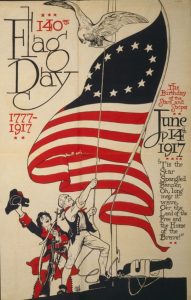 When the American Revolution broke out in 1775, the colonists weren’t fighting united under a single flag. Instead, most regiments participating in the war for independence against the British fought under their own flags. In June of 1775, the Second Continental Congress met in Philadelphia to create the Continental Army—a unified colonial fighting force—with the hopes of more organized battle against its colonial oppressors. This led to the creation of what was, essentially, the first “American” flag, the Continental Colors. For some, this flag, which was comprised of 13 red and white alternating stripes and a Union Jack in the corner, was too similar to that of the British. George Washington soon realized that flying a flag that was even remotely close to the British flag was not a great confidence-builder for the revolutionary effort, so he turned his efforts towards creating a new symbol of freedom for the soon-to-be fledgling nation.
When the American Revolution broke out in 1775, the colonists weren’t fighting united under a single flag. Instead, most regiments participating in the war for independence against the British fought under their own flags. In June of 1775, the Second Continental Congress met in Philadelphia to create the Continental Army—a unified colonial fighting force—with the hopes of more organized battle against its colonial oppressors. This led to the creation of what was, essentially, the first “American” flag, the Continental Colors. For some, this flag, which was comprised of 13 red and white alternating stripes and a Union Jack in the corner, was too similar to that of the British. George Washington soon realized that flying a flag that was even remotely close to the British flag was not a great confidence-builder for the revolutionary effort, so he turned his efforts towards creating a new symbol of freedom for the soon-to-be fledgling nation.
On June 14, 1777, the Second Continental Congress took a break from writing the Articles of Confederation and passed a resolution stating that “the flag of the United States be 13 stripes, alternate red and white,” and that “the union be 13 stars, white in a blue field, representing a new constellation.”
In 1916, President Woodrow Wilson marked the anniversary of that decree by officially establishing June 14 as Flag Day. As you celebrate the anniversary of the Stars and Stripes, here are some fast facts about “Old Glory.”
• Bernard Cigrand, a small-town Wisconsin teacher, originated the idea for an annual flag day, to be celebrated across the country every June 14, in 1885. That year, he led his school in the first formal observance of the holiday. Cigrand, who later changed careers and practiced dentistry in Illinois, continued to promote his concept and advocate respect for the flag throughout his life.
• It is widely believed that Betsy Ross, who assisted the Revolutionary War effort by repairing uniforms and sewing tents, made and helped design the first American flag. However, there is no historical evidence that she contributed to Old Glory’s creation. It was not until her grandson William Canby held an 1870 press conference to recount the story that the American public learned of her possible role.
• The lyrics of “The Star-Spangled Banner,” America’s national anthem since 1931, are taken from a patriotic poem written by Francis Scott Key after he witnessed the Battle of Fort McHenry during the War of 1812. His words were set to the tune of “To Anacreon in Heaven,” a popular British drinking song.
• In the 1950s, when it seemed certain that Alaska would be admitted to the Union, designers began retooling the American flag to add a 49th star to the existing 48. Meanwhile, a 17-year-old Ohioan student named Bob Heft borrowed his mother’s sewing machine, disassembled his family’s 48-star flag and stitched on 50 stars in a proportional pattern. He handed in his creation to his history teacher for a class project, explaining that he expected Hawaii would soon achieve statehood as well. Heft also sent the flag to his congressman, Walter Moeller, who presented it to President Eisenhower after both new states joined the Union. Eisenhower selected Heft’s design, and on July 4, 1960, the president and the high school student stood together as the 50-star flag was raised for the first time. Heft’s teacher promptly changed his grade from a B- to an A.
• During the Vietnam War era, some demonstrators burned American flags as an act of protest. The Flag Protection Act of 1968 was enacted in response, making it illegal to burn or otherwise deface the Stars and Stripes. In two landmark decisions 20 years later, the Supreme Court ruled that the government couldn’t curb individuals’ First Amendment rights by prohibiting desecration of the U.S. flag. Respectful burning of damaged flags according to established protocol has always been acceptable.
The United States Flag Code states: “The flag, when it is in such a condition that it is no longer a fitting emblem for display, should be destroyed in a dignified way, preferably by burning.” The Ceremony for Disposal of Unserviceable Flags is outlined in Resolution No, 440, passed by the 19th National Convention of The American Legion in New York, September 20 – 23, 1937. The ceremony has been an integral part of American Legion ritual since that date.
Post 24 will recognize Flag Day this year on Sunday, 14 June at the Boy Scout Memorial near the Marlborough School beginning at 3PM. The Disposal Ceremony will be modified to ensure that social distancing is strictly adhered to. Main Crust Company on Ling Street has been designated as the flag drop off point for any and all worn, tattered or unserviceable U.S. Flags that require proper disposal. If you would like to arrange to have flags picked up, send an email to post24americanlegion@gmail.com to request assistance.
Sources: History Channel. “What is Flag Day?” History Channel.com, 9 May 2020, www.historychannel.com/flagday The American Legion. Officer’s Guide and Manual of Ceremonies, 2017.

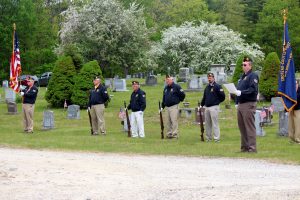 Thank you for being here today, it is my honor to be standing here in front of you. This memorial day has some unique differences, this country has been going through a crisis and every crisis has new heroes. During the 9/11 attacks, they were the first responders running into burning and crumbling buildings as others ran out. Now, during the Coronavirus pandemic, the most visible heroes are the health care professionals, who are saving others and risking their own lives while doing so.
Thank you for being here today, it is my honor to be standing here in front of you. This memorial day has some unique differences, this country has been going through a crisis and every crisis has new heroes. During the 9/11 attacks, they were the first responders running into burning and crumbling buildings as others ran out. Now, during the Coronavirus pandemic, the most visible heroes are the health care professionals, who are saving others and risking their own lives while doing so.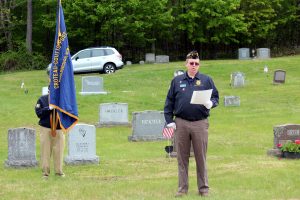 As we celebrate the selfless and untiring performances of the healthcare workers during the COVID-19 pandemic, it brings to mind the military medics, doctors, and nurses who sacrificed their lives while treating others on the battlefield.
As we celebrate the selfless and untiring performances of the healthcare workers during the COVID-19 pandemic, it brings to mind the military medics, doctors, and nurses who sacrificed their lives while treating others on the battlefield.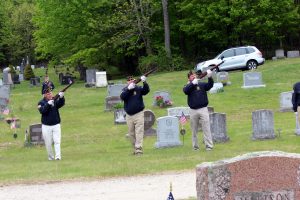 Not all have died from enemy fire. Some have died from diseases that fester around war zones. Oftentimes, deaths from disease and accidents outnumbered the casualties caused by enemy weapons.
Not all have died from enemy fire. Some have died from diseases that fester around war zones. Oftentimes, deaths from disease and accidents outnumbered the casualties caused by enemy weapons.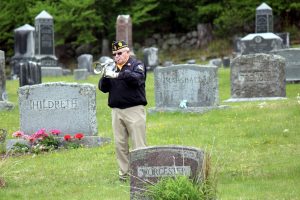 Even when the enemy is an invisible virus or a microscopic germ, the sacrifices made are just as meaningful.
Even when the enemy is an invisible virus or a microscopic germ, the sacrifices made are just as meaningful.